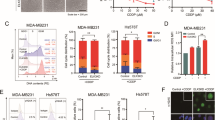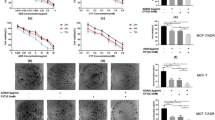Abstract
There is considerable evidence that ionizing radiation (IR) and chemotherapeutic drugs mediate apoptosis through the intrinsic death pathway via the release of mitochondrial cytochrome c and activation of caspases -9 and -3. Here we show that MCF-7 cells that lack caspase-3 undergo a caspase-dependent apoptotic cell death in the absence of DNA fragmentation and α-fodrin cleavage following treatment with etoposide or doxorubicin, but not after exposure to IR. Re-expression of caspase-3 restored DNA fragmentation and α-fodrin cleavage following drug treatment, but it did not alter the radiation-resistant phenotype of these cells. In contrast to the anticancer drugs, IR failed to induce the intrinsic death pathway in MCF-7/casp-3 cells, an event readily observed in IR-induced apoptosis of HeLa cells. Although IR-induced DNA double-strand breaks were repaired with similar efficiencies in all cell lines, cell cycle analyses revealed a persistent G2/M arrest in the two MCF-7 cell lines, but not in HeLa cells. Together, our data demonstrate that caspase-3 is required for DNA fragmentation and α-fodrin cleavage in drug-induced apoptosis and that the intrinsic death pathway is fully functional in MCF-7 cells. Furthermore, they show that the radiation-resistant phenotype of MCF-7 cells is not due to the lack of caspase-3, but is caused by the failure of IR to activate the intrinsic death pathway. We propose (1) different signaling pathways are induced by anticancer drugs and IR, and (2) IR-induced G2/M arrest prevents the generation of an apoptotic signal required for the activation of the intrinsic death pathway.
This is a preview of subscription content, access via your institution
Access options
Subscribe to this journal
Receive 50 print issues and online access
$259.00 per year
only $5.18 per issue
Buy this article
- Purchase on Springer Link
- Instant access to full article PDF
Prices may be subject to local taxes which are calculated during checkout






Similar content being viewed by others
Abbreviations
- TNF:
-
tumor necrosis factor
- IR:
-
ionizing radiation
- zVAD-fmk:
-
benzyloxycarbonyl-Val-Ala-Asp-fluoromethylketone
- PARP:
-
poly(ADP-ribose)polymerase
- DEVD-amc:
-
N-acetyl-Asp-Glu-Val-Asp-7-amino-4-methylcoumarin
References
Ashkenazi A, Dixit VM . 1998 Science 281: 1305–1308
Belka C, Marini P, Lepple Wienhues A, Budach W, Jekle A, Los M, Lang F, Schulze-Osthoff K, Gulbins E, Bamberg M . 1999 Oncogene 18: 4983–4992
Bunz F, Dutriaux A, Lengauer C, Waldman T, Zhou S, Brown JP, Sedivy JM, Kinzler KW, Vogelstein B . 1998 Science 282: 1497–1501
Chen Q, Gong B, Almasan A . 2000 Cell Death Differ. 7: 227–233
Clarke AR, Purdie CA, Harrison DJ, Morris RG, Bird CC, Hooper ML, Wyllie AH . 1993 Nature 362: 849–852
Cryns V, Yuan J . 1998 Genes Dev. 12: 1551–1570
Datta R, Kojima H, Banach D, Bump NJ, Talanian RV, Alnemri ES, Weichselbaum RR, Wong WW, Kufe DW . 1997 J. Biol. Chem. 272: 1965–1969
Droin N, Dubrez L, Eymin B, Renvoizé C, Bréard J, Dimanche-Boitrel MT, Solary E . 1998 Oncogene 16: 2885–2894
Dubrez L, Savoy I, Hamman A, Solary E . 1996 EMBO J. 15: 5504–5512
Engels IH, Stepczynska A, Stroh C, Lauber K, Berg C, Schwenzer R, Wajant H, Jänicke RU, Porter AG, Belka C, Gregor M, Schulze-Osthoff K, Wesselborg S . 2000 Oncogene 19: 4563–4573
Faleiro L, Kobayashi R, Fearnhead H, Lazebnik Y . 1997 EMBO J. 16: 2271–2281
Fan S, El-Deiry WS, Bae I, Freeman J, Jondle D, Bhatia K, Fornace Jr AJ, Magrath I, Kohn KW, O'Connor PM . 1994 Cancer Res. 54: 5824–5830
Fan S, Smith ML, Rivet II DJ, Duba D, Zhan Q, Kohn KW, Fornace Jr AJ, O'Connor PM . 1995 Cancer Res. 55: 1649–1654
Ferrari D, Stepczynska A, Los M, Wesselborg S, Schulze-Osthoff K . 1998 J. Exp. Med. 188: 979–984
Fisher DE . 1994 Cell 78: 539–542
Fuchs EJ, McKenna KA, Bedi A . 1997 Cancer Res. 57: 2550–2554
Hakem R, Hakem A, Duncan GS, Henderson JT, Woo M, Soengas MS, Elia A, de la Pompa JL, Kagi D, Khoo W, Potter J, Yoshida R, Kaufman SA, Lowe SW, Penninger JM, Mak TW . 1998 Cell 94: 339–352
Hannun YA . 1997 Blood 89: 1845–1853
Heenan M, Kavanagh K, Redmond A, Maher M, Dolan E, O'Neill P, Moriarty M, Clynes M . 1996 Cytotechnology 19: 237–242
Hollstein M, Sidransky D, Vogelstein B, Harris CC . 1991 Science 253: 49–53
Jänicke RU, Lee FHH, Porter AG . 1994 Mol. Cell. Biol. 14: 5661–5670
Jänicke RU, Lin XY, Lee FHH, Porter AG . 1996 Mol. Cell. Biol. 16: 5245–5253
Jänicke RU, Ng P, Sprengart ML, Porter AG . 1998a J. Biol. Chem. 273: 15540–15545
Jänicke RU, Sprengart ML, Wati MR, Porter AG . 1998b J. Biol. Chem. 273: 9357–9360
Kischkel FC, Hellbardt S, Behrmann I, Germer M, Pawlita M, Krammer PH, Peter ME . 1995 EMBO J. 14: 5579–5588
Klaude M, Eriksson S, Nygren J, Ahnström G . 1996 Mutat. Res. 363: 89–96
Ko LJ, Prives C . 1996 Genes Dev. 10: 1054–1072
Kuida K, Haydar TF, Kuan C-Y, Gu Y, Taya C, Karasuyama H, Su MS-S, Rakic P, Flavell RA . 1998 Cell 94: 325–337
Kuida K, Zheng TS, Na S, Kuan C-Y, Yang D, Karusuyama H, Rakic P, Flavell RA . 1996 Nature 384: 368–372
Lee Y-J, Shacter E . 1999 J. Biol. Chem. 274: 19792–19798
Lehnert S, Greene D, Batist G . 1989 Radiat. Res. 118: 568–580
Levenson AS, Jordan VC . 1997 Cancer Res. 57: 3071–3078
Levine AJ . 1997 Cell 88: 323–331
Li F, Srinivasan A, Wang Y, Armstrong RC, Tomaselli KJ, Fritz LC . 1997a J. Biol. Chem. 272: 30299–30305
Li P, Nijhawan D, Budihardjo I, Srinivasula SM, Ahmad M, Alnemri ES, Wang X . 1997b Cell 91: 479–489
Lowe SW, Ruley HE, Jacks T, Housman DE . 1993 Cell 74: 957–967
Martins LM, Kottke T, Mesner PW, Basi GS, Sinha S, Frigon Jr N, Tatar E, Tung JS, Bryant K, Takahashi A, Svingen PA, Madden BJ, McCormick DJ, Earnshaw WC, Kaufmann SH . 1997 J. Biol. Chem. 272: 7421–7430
Muzio M, Chinnaiyan AM, Kischkel FC, O'Rourke K, Shevchenko A, Ni J, Scaffidi C, Bretz JD, Zhang M, Gentz R, Mann M, Krammer PH, Peter ME, Dixit VM . 1996 Cell 85: 817–827
Nicholson DW, Thornberry NA . 1997 Trends Biochem. Sci. 8: 299–306
Nicoletti I, Migliorati G, Pagliacci MC, Grignani F, Riccardi C . 1991 J. Immunol. Methods 139: 271–279
Oshita F, Fujiwara Y, Saijo NJ . 1992 Cancer Res. Clin. Oncol. 119: 28–34
Porter AG, Jänicke RU . 1999 Cell Death Differ. 6: 99–104
Porter AG, Ng P, Jänicke RU . 1997 BioEssays 19: 501–507
Sabbatini P, Han J, Chiou SK, Nicholson DW, White E . 1997 Cell Growth Diff. 8: 643–653
Schmitt CA, Lowe SW . 1999 J. Pathol. 187: 127–137
Schuler M, Bossy-Wetzel E, Goldstein JC, Fitzgerald P, Green DR . 2000 J. Biol. Chem. 275: 7337–7342
Simizu S, Takada M, Umezawa K, Imoto M . 1998 J. Biol. Chem. 273: 26900–26907
Sionov RV, Haupt Y . 1999 Oncogene 18: 6145–6157
Slee EA, Harte MT, Kluck RM, Wolf BB, Casiano CA, Newmeyer DD, Wang HG, Reed JC, Nicholson DW, Alnemri ES, Green DR, Martin SJ . 1999 J. Cell. Biol. 144: 281–292
Soengas MS, Alarcón RM, Yoshida H, Giaccia AJ, Hakem R, Mak TW, Lowe SW . 1999 Science 284: 156–159
Soengas MS, Capodieci P, Polsky D, Mora J, Esteller M, Opitz-Araya X, McCombie R, Herman JG, Gerald WL, Lazebnik YA, Cordon-Cardo C, Lowe SW . 2001 Nature 409: 207–211
Srinivasula SM, Ahmad M, Fernandes-Alnemri T, Litwack G, Alnemri ES . 1996 Proc. Natl. Acad. Sci. USA 93: 14486–14491
Talanian RV, Quinlan C, Trautz S, Hackett MC, Mankovich JA, Banach D, Ghayur T, Brady KD, Wong WW . 1997 J. Biol. Chem. 272: 9677–9682
Thornberry NA, Lazebnik Y . 1998 Science 281: 1312–1316
Van de Craen M, Loo GV, Pype S, Criekinge WV, Van den Brande I, Molemans F, Fiers W, Declercq W, Vandenabeele P . 1998 Cell Death Diff. 5: 838–846
Vander Heiden MG, Thompson CB . 1999 Nature Cell Biol. 1: E209–E216
Vassault A . 1983 In Methods of Enzymatic Analysis Bergmeyer, HU (ed) Verlag Chemie, Basel, Switzerland pp. 118–126
Wang YJ . 1998 Curr. Opin. Cell Biol. 10: 240–247
Wertz IE, Hanley MR . 1996 Trends Biochem. Sci. 21: 359–364
Wesselborg S, Engels IH, Rossmann E, Los M, Schulze-Osthoff K . 1999 Blood 93: 3053–3063
Woo M, Hakem R, Soengas MS, Duncan GS, Shahinian A, Kägi D, Hakem A, McCurrach M, Khoo W, Kaufman SA, Senaldi G, Howard T, Lowe SW, Mak TW . 1998 Genes Dev. 12: 806–819
Yu Y, Little JB . 1998 Cancer Res. 58: 4277–4281
Zhan Q, Fan S, Bae I, Guillouf C, Liebermann DA, O'Connor PM, Fornace Jr AJ . 1994 Oncogene 9: 3743–3751
Zheng TS, Schlosser SF, Dao T, Hingorani R, Crispe N, Boyer JL, Flavell RA . 1998 Proc. Natl. Acad. Sci., USA 95: 13618–13623
Acknowledgements
We thank Alwin Teo for his help with the cell cycle analysis and Mr Hwang (Physics Department, National University of Singapore) for the use of the gamma chamber. This work was funded by the Institute of Molecular and Cell Biology, the Deutsche Krebshilfe and the Deutsch-Israelische Projektkoordination (DIP).
Author information
Authors and Affiliations
Corresponding author
Rights and permissions
About this article
Cite this article
Jänicke, R., Engels, I., Dunkern, T. et al. Ionizing radiation but not anticancer drugs causes cell cycle arrest and failure to activate the mitochondrial death pathway in MCF-7 breast carcinoma cells. Oncogene 20, 5043–5053 (2001). https://doi.org/10.1038/sj.onc.1204659
Received:
Revised:
Accepted:
Published:
Issue Date:
DOI: https://doi.org/10.1038/sj.onc.1204659
Keywords
This article is cited by
-
Metabolic targets of watercress and PEITC in MCF-7 and MCF-10A cells explain differential sensitisation responses to ionising radiation
European Journal of Nutrition (2019)
-
Allogeneic hematopoietic cell transplantation as curative therapy for non-transformed follicular lymphomas
Bone Marrow Transplantation (2016)
-
Targeting the epigenetics of the DNA damage response in breast cancer
Cell Death & Disease (2016)
-
Anti-KIT designer T cells for the treatment of gastrointestinal stromal tumor
Journal of Translational Medicine (2013)
-
S-nitrosylation of ERK inhibits ERK phosphorylation and induces apoptosis
Scientific Reports (2013)



